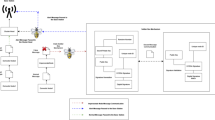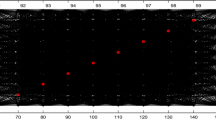Abstract
A wireless sensor network (WSN) consists of sensor nodes and wireless communication. Sensor nodes usually have the features such as tiny size, low cost, low power consumption. They are used for environmental monitoring and transmit sensing data (temperature, humidity, pressure and so on) to sink through wireless networking. To protect sensing data’s confidentiality and integrity has presented an intrusion detection system called patrol intrusion detection system (PIDS), which designate a fraction of sensor nodes as roaming patrol nodes to detect malicious sensor nodes. However, those patrol nodes’ battery energy will consume rapidly and thus makes the whole WSN to have reduced lifetime. In this paper, the system will collect ambient data and utilize a revised artificial bee colony algorithm to find a low power consumption path for transmitting attack feature packets in PIDS in order to extend the lifetime of a WSN.




Similar content being viewed by others
References
Asogwa C-O, Zhang X, Xiao D, Hamed A (2012) Experimental analysis of AODV, DSR and DSDV protocols based on wireless body area network. Commun Comput Inf Sci 312:183–191
Atmojo UD, Salcic Z, Wang KI-K, Park HJ (2015) System-level approach to the design of ambient intelligence systems based on wireless sensor and actuator networks 6(2):153–169
Bajaber F, Awan I (2010) Energy efficient clustering protocol to enhance lifetime of wireless sensor network. J Ambient Intell Humaniz Comput 1(4):239–248
Chen RC, Hsieh CF, Huang YF (2010) An isolation intrusion detection system for hierarchical wireless sensor networks. J Netw 5(3):335–342
Ding W, Ma Y (2012) The application of wireless sensor in aquaculture water quality monitoring. IFIP Adv Inf Commun Technol 370:502–507
Doherty L, Simon J, Watteyne T (2012) Wireless sensor network challenges and solutions. Microw J 55(8):22–34
Dorigo M, Birattari M, Stutzle T (2006) Ant colony optimization. IEEE Comput Intell Mag 1(4):28–39
Guo W, Zhang W, Lu G (2010) A comprehensive routing protocol in wireless sensor network based on ant colony algorithm. Netw Secur Wirel Commun Trust Comput 1:41–44
Haberman BK, Sheppard JW (2012) Overlapping particle swarms for energy-efficient routing in sensor networks. Wirel Netw 18(4):351–363
He S, Dai Y, Zhou R, Zhao S (2012) A clustering routing protocol for energy balance of WSN based on genetic clustering algorithm. IERI Procedia 2:788–793
Heinzelman W, Chandrakasan A, Balakrishnan H (2002) An application-specific protocol architecture for wireless microsensor networks. Wirel Commun 1(4):660–670
Hornga S-J, Suc M-Y, Chenb Y-H et al (2011) A novel intrusion detection system based on hierarchical clustering and support vector machines. Expert Syst Appl 38(1):306–313
Hsieh CF, Huang YF, Chen RC (2011) A light-weight ranger intrusion detection system on wireless sensor networks. In: IEEE the fifth international conference on genetic and evolutionary computing, pp 49–52
Johnson D, Hu Y, Maltz D (2007) The dynamic source routing protocol (DSR) for mobile ad hoc networks for Ipv4. RFC 4728. http://tools.ietf.org/html/rfc4728. Accessed 26 Dec 2012
Karaboga D, Basturk B (2008) On the performance of artificial bee colony algorithm. Appl Soft Comput 8(1):687–697
Karaboga D, Gorkemli B, Ozturk C, Karaboga N (2014) A comprehensive survey: artificial bee colony (ABC) algorithm and applications. Artif Intell Rev 42(1):21–57
Kennedy J, Eberhart R (1995) Particle swarm optimization. IEEE Int Conf Neural Netw 4:1942–1948
Kiani SL, Anjum A, Antonopoulos N, Knappmeyer M (2014) Context-aware service utilisation in the clouds and energy conservation. J Ambient Intell Humaniz Comput 5(1):111–131
Kim T-H, Fang W-C, Ramos C et al (2012) Ubiquitous sensor networks and its application. Int J Distrib Sens Netw 2012:1–3
Liu CY, Woungang I, Chao HC et al (2011) Message security in multi-path Ad Hoc networks using a neural network-based cipher. IEEE Globecom 2011:1–5
Liu Y, Dai W, Xu K, Zheng (2012) A hybrid routing tree to avoid the energy hole problem in wireless sensor network. Adv Intell Soft Comput 143:869–876
Nguyen TA, Raspitzu A, Marco Aiello (2014) Ontology-based office activity recognition with applications for energy savings. J Ambient Intell Humaniz Comput 5(5):667–681
Perkins C, Beldingroyer E, Das S (2003) Ad hoc on-demand distance vector (AODV) routing. RFC 3561. http://www.faqs.org/rfcs/rfc3561.html. Accessed 26 Dec 2012
Saxena A, Prakash V (2012) Simulation study of AODV and DSR routing protocol in wireless Ad-Hoc networks. Int J Eng Sci Res 2:741–748
Sunita M, Malik J, Mor S (2012) Comprehensive study of applications of wireless sensor network. Int J Adv Res Comput Sci Softw Eng 2(11):56–60
Toosi AN, Kahani M (2007) A new approach to intrusion detection based on an evolutionary soft computing model using neuro-fuzzy classifiers. Comput Commun 30(10):2201–2212
Zungeru AM, Ang LM, Seng KP (2012) Classical and swarm intelligence based routing protocols for wireless sensor networks: a survey and comparison. J Netw Comput Appl 35(5):1508–1536
Acknowledgments
This research was supported by the Ministry of Science and Technology, Taiwan, ROC, under contract number MOST103-2632-E-324-001-MY3.
Author information
Authors and Affiliations
Corresponding author
Rights and permissions
About this article
Cite this article
Chen, RC., Hsieh, CF. & Chang, WL. Using ambient intelligence to extend network lifetime in wireless sensor networks. J Ambient Intell Human Comput 7, 777–788 (2016). https://doi.org/10.1007/s12652-015-0323-6
Received:
Accepted:
Published:
Issue Date:
DOI: https://doi.org/10.1007/s12652-015-0323-6




